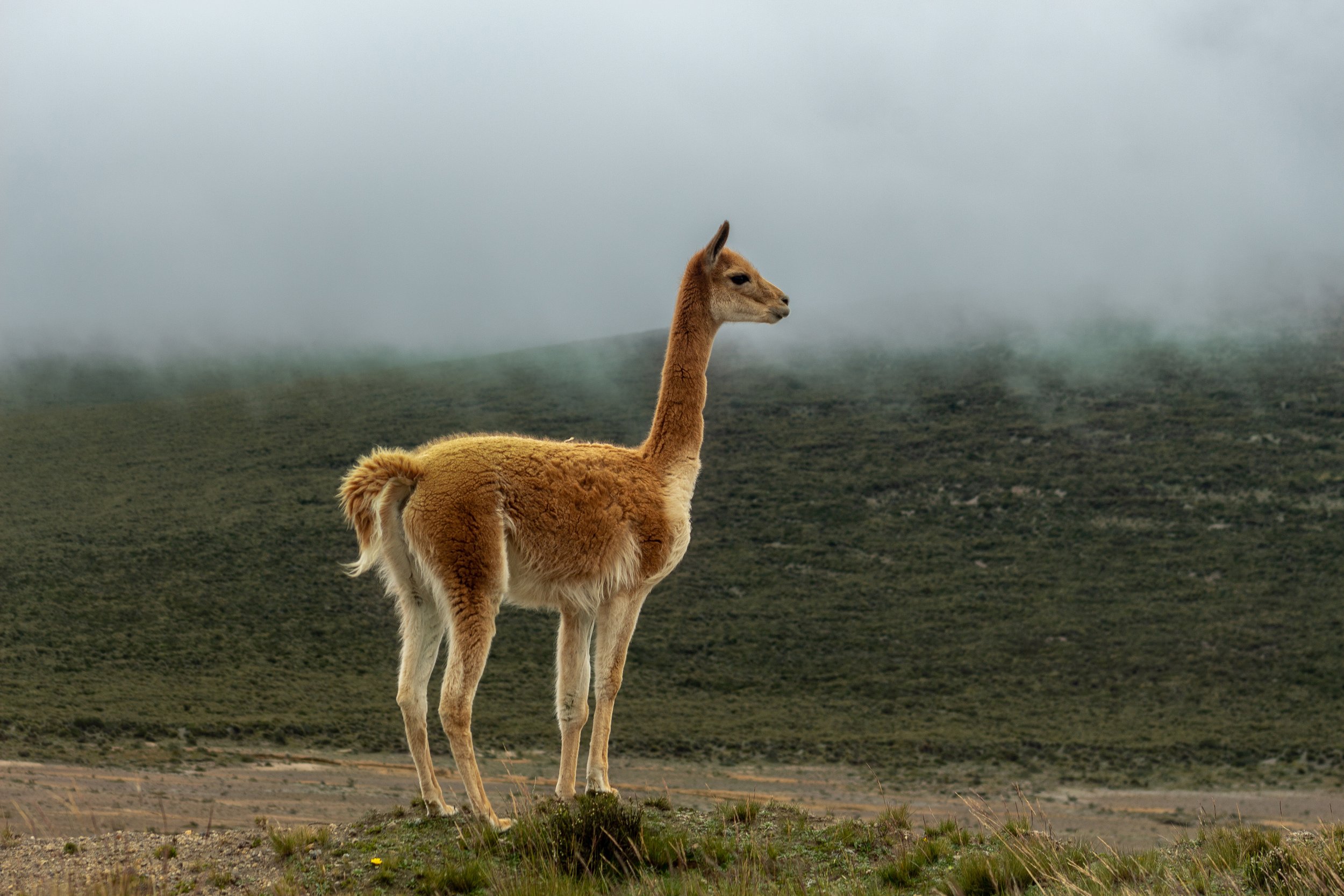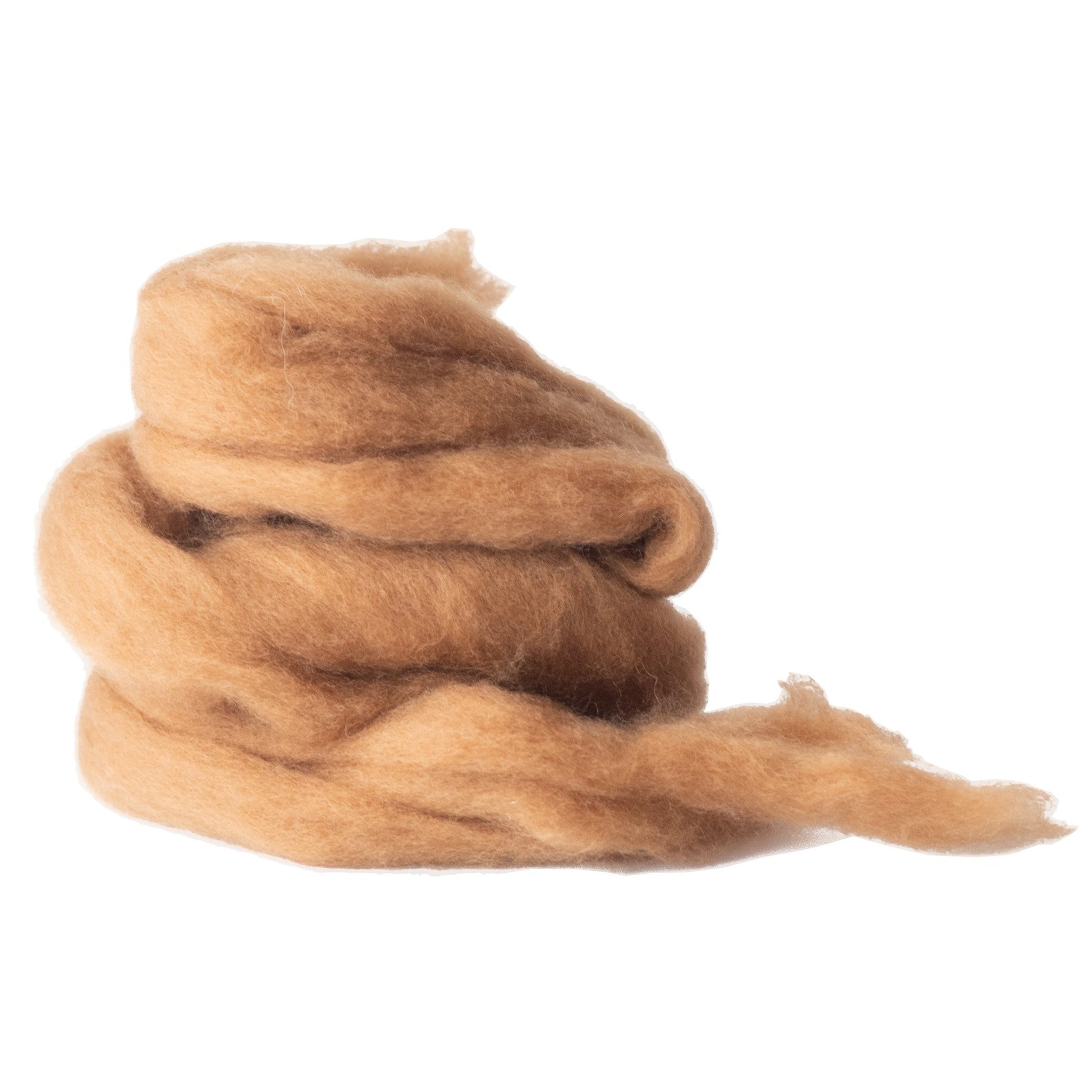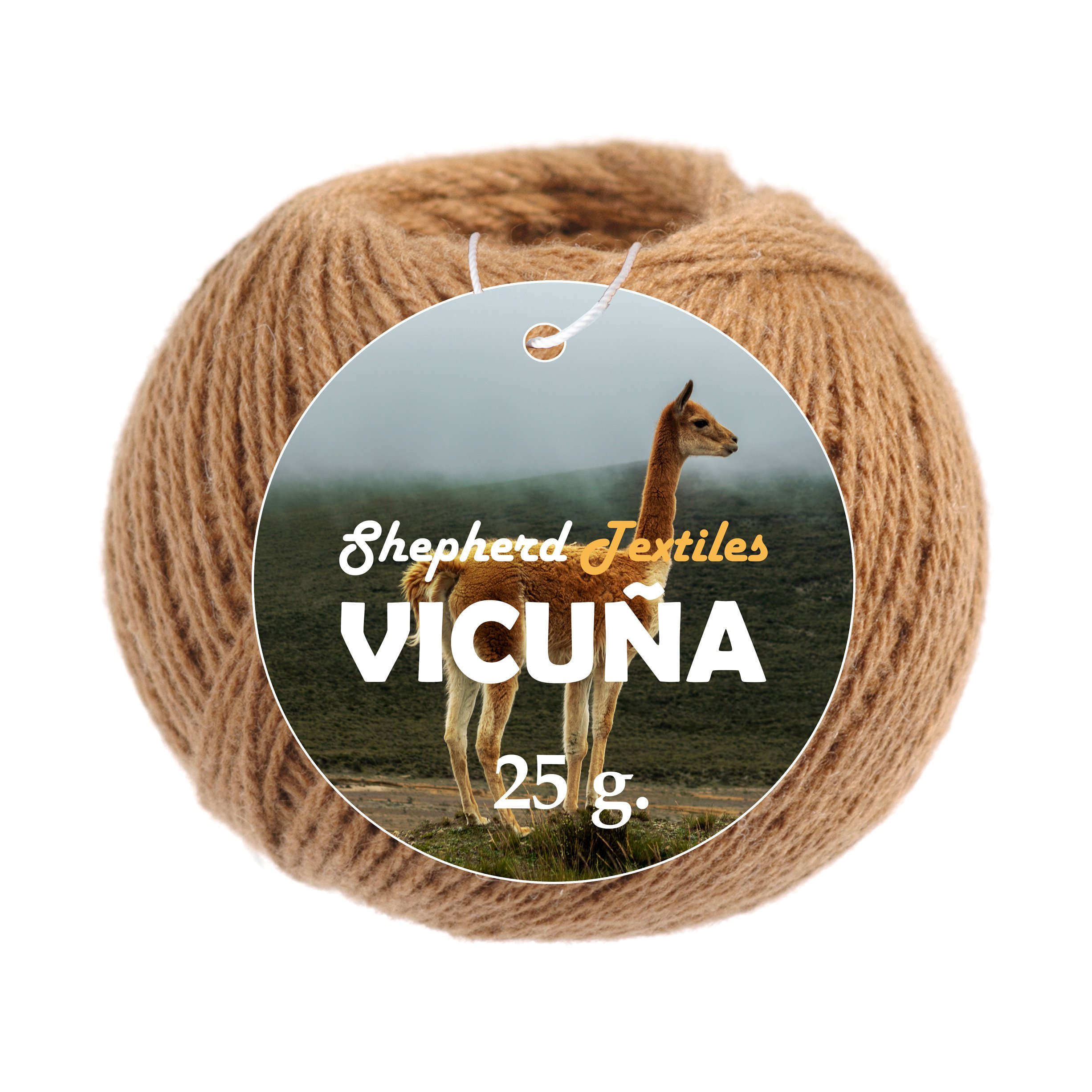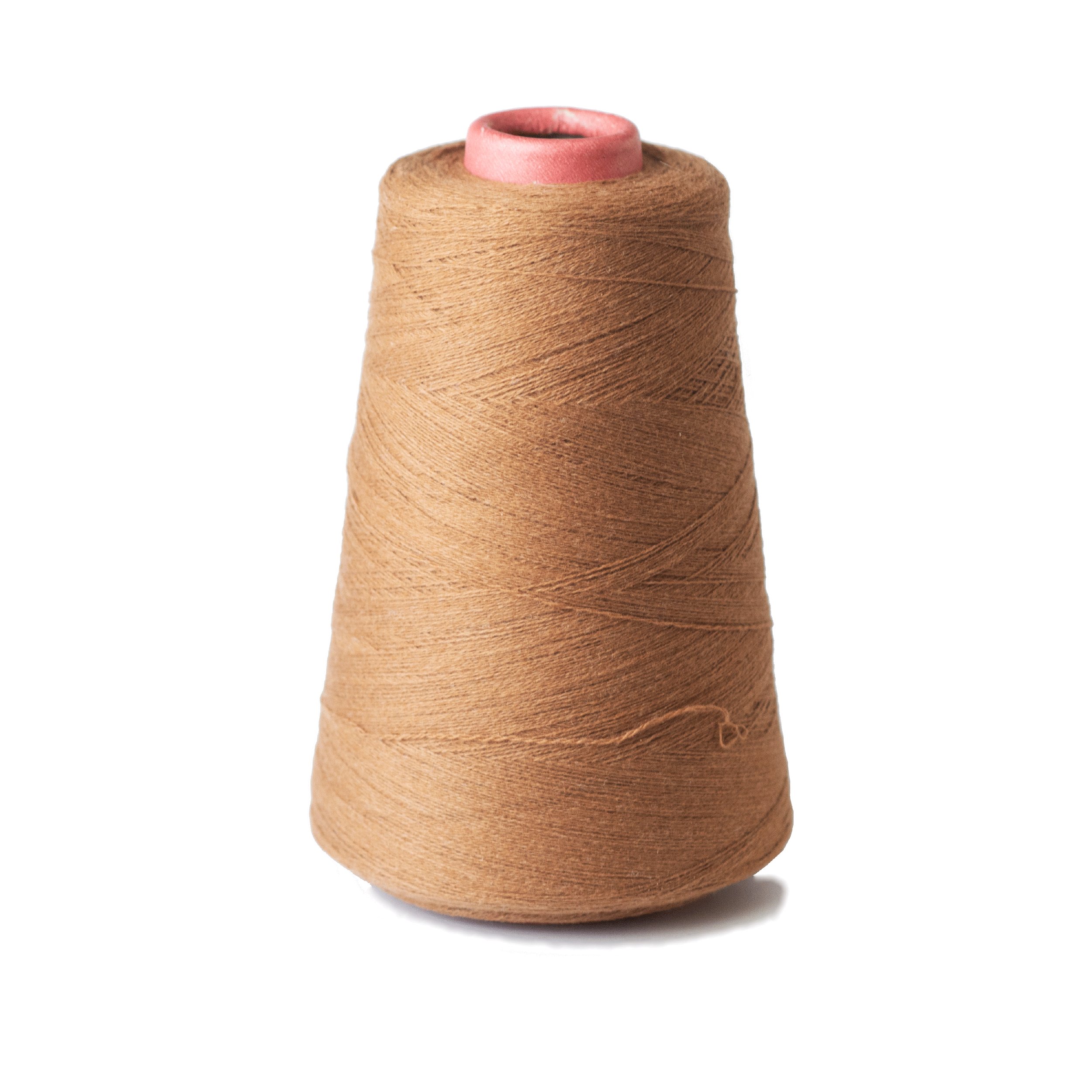
Wild Andean Vicuña.
Vicuña
Vicuña are the wild ancestors of domesticated alpaca, and their fleeces contain the finest and most luxurious natural fibers in existence. Small populations still inhabit the Andes mountains, and once a year, indigenous communities work together to drive the local vicuña into temporary paddocks made of netting. The vicuña are gently shorn and then released back into the wild for another year. This process is heavily regulated by international convention, and only a tiny quantity of vicuña fiber is harvested annually. Most is immediately bought up by Italian fashion houses. A four-ounce vicuña scarf currently retails for around $3,000—or $27 per gram—and a vicuña jacket for closer to $20,000. We import our vicuña from mills in Italy and South America. We are making the raw fiber and yarn available for the first time for hand-spinners, knitters, and fiber artists.
Pure vicuña fiber. Carded and combed at a specialized mill in Argentina, and ready for hand-spinning, blending, or felting.
100% Vicuña Yarn, Fingering Weight (3/16)
Soft as a cloud, this fluffy knitting yarn was spun for us in Italy from 100% wild vicuña fiber.
100% Vicuña Yarn, Lace Weight (2/28)
A lace-weight yarn for weaving fabrics of unparalleled luxury. Use it as weft to experience the opulence of real vicuña.
Frequently Asked Questions
-
Several factors determine how soft a fiber feels, including crimp (how springy it is) and smoothness. However, the most important factor is fineness. How thick is each individual fiber? Finer fibers feel softer to the human touch. Fineness is measured in terms of the Average Fiber Diameter (AFD) for a given sample. Human hair has an average diameter of about 50 microns; rough wool about 30 microns; merino wool usually around 18-22 microns; and really fine grades of cashmere between 15 and 16 microns. Vicuña fibers have an average diameter of only 12 or 13 microns, and a large proportion of the fibers measure less than 10 microns. This is why vicuña is renowned as the softest and most luxurious of all natural fibers. It feels like touching a cloud.
-
There are two ways to confirm that vicuña is authentic and not adulterated with cheaper wools. The first is to request the paperwork documenting chain of custody; any legitimate supplier of vicuña will be willing to provide a CITES export certificate showing their business name and the country of origin of their vicuña product. The second way is to directly test the fiber itself.
All trade in vicuña products, from shearing to milling to sales of yarn, is strictly regulated by the Convention on International Trade in Endangered Species (CITES). This creates a paperwork trail proving that the vicuña wool originated from healthy wild populations (listed in Appendix II) and not from endangered populations (listed in Appendix I). To export any vicuña products across national borders, whether from the carding mill in Argentina to the spinning mill in Italy, or from Italy to the USA, the exporter must apply for a CITES certificate that also lists the name and address of the importing company. This process can take weeks or months, depending on how long it takes CITES officials to confirm that the vicuña was properly harvested. If there is no accompanying CITES certificate, vicuña products will immediately be seized by customs. It is not possible to get real vicuña into the U.S. without this certificate; any vendor selling real vicuña will be able to provide a copy of their own certificates. International sellers offering to ship you “vicuña” without applying for a CITES certificate for you are not selling real vicuña; most likely you are getting fawn-colored alpaca, or wool dyed with cutch.
The second way to confirm that vicuña is authentic is to test the fiber itself. If you have raw wool, you can send a sample to a fiber testing laboratory. We prefer Alpaca Consulting USA in California; they use a professional OFDA machine, have a quick turn-around time, and charge very reasonable rates. You will need a piece of fiber about the size of your thumb. If you have a woven piece it is a little more difficult; the best way is to see if you can pull some loose fibers out of the fringe. Vicuña has a very short staple length; almost none of the fibers are longer than an inch and a half. In contrast, most alpaca and wool fibers will be at least 3” to 6” long. If you can pull some fiber out of the fringes, or tease apart a piece of yarn, check to see how long most of the individual fibers are. If most of them are in the 3” to 6” range, it is not real vicuña.
-
Unfortunately we cannot ship vicuña products to customers outside the US. Any international sales would require a CITES Re-Export Certificate; the associated paperwork is lengthy, legally complex, and can take weeks or months for approval. As a result, we can only ship vicuña products within the US.
-
Vicuña are a protected species and it is illegal to hunt them, harm them, or kill them for their wool. All of our vicuña products come from vicuña that were sheared and then released back into the wild. However, occasionally in old books or articles you will find references to vicuña being killed for their pelts. That practice was fortunately outlawed in the 1970s, and as a result wild populations of vicuña have made a dramatic recovery.
-
Vicuña is the most expensive natural fiber, often up to 10 times as expensive as the finest pashmina. This is a result of two factors: the extremely limited supply, and the cost of the custom-made equipment required to process it.
Supply and demand is the major contributing factor. The natural population of vicuña remains quite small, numbering just a few hundred thousand, and they mostly live in remote reaches of the Andes mountains. They are not prolific fiber producers—they only grow an inch or so of fiber per year compared to many sheep breeds that easily grow six or seven times as much. As a result, the total amount of vicuña wool harvested annually in all of South America only amounts to a few thousand kilograms. By way of comparison, China alone produces more than 10 million kilograms of cashmere every year. Vicuña fiber is highly desirable and there is never enough of it to meet demand, which makes it more expensive than other natural fibers.
The other reason vicuña is expensive is that vicuña’s fineness presents unique challenges for fiber mills. Vicuña fibers are difficult to card (comb into a uniform roving). Carding machines use metal teeth to open fibers up and align them in the same direction. However, vicuña fibers are so fine that carding machines designed for wool or alpaca will either rip and damage the fibers, or just not catch them at all. The short staple length is another challenge: most carding machines are designed to separate and drop out short fibers because they are less desirable for spinning yarn. Standard spinning machines cannot spin yarn out of 1-inch long fibers, either. The yarn has little “backbone” to hold the fibers together and they will easily pull apart. To address these challenges, several of the major Italian fashion companies jointly designed special machines for carding and spinning vicuña. However, these are expensive to engineer, build, and maintain, and the cost contributes to the high price of vicuña.
-
Vicuña wool is naturally a beautiful cinnamon brown color, and most luxury fashion houses will only offer it in that color. The reason is that dyeing a fiber can very easily damage the “hand” or the softness of it, and if you are paying a premium for vicuña you want the softness above all. Textile dyes—whether mordant dyes, acid dyes, or direct dyes—generally require the application of water and heat to permanently dye fiber. Water, heat, and acids and alkalis can all damage the microscopic scales on animal fibers, especially very fine fibers like vicuña. This can make the fiber feel rougher. As a result, most fashion professionals will only offer vicuña in its natural color and occasionally in black. For a fiber with more color options, we recommend cashmere or baby alpaca.




